Nursing Research: Design Methods Analysis, Causality & Validity
VerifiedAdded on 2023/06/10
|8
|3297
|490
Homework Assignment
AI Summary
This assignment provides a detailed analysis of research design methods in nursing, covering quantitative, qualitative, and mixed methods approaches. It explores key concepts such as causality, necessary and sufficient conditions, multicausality, probability, bias, manipulation, and control. The assignment also discusses different types of study validity, including statistical conclusion validity, internal validity, construct validity, and external validity. Furthermore, it outlines the essential elements of a good research design and discusses various design control strategies. The document elucidates sequential, concurrent, and transformative procedures in mixed-methods studies. Desklib offers this and many more solved assignments to help nursing students excel in their studies.
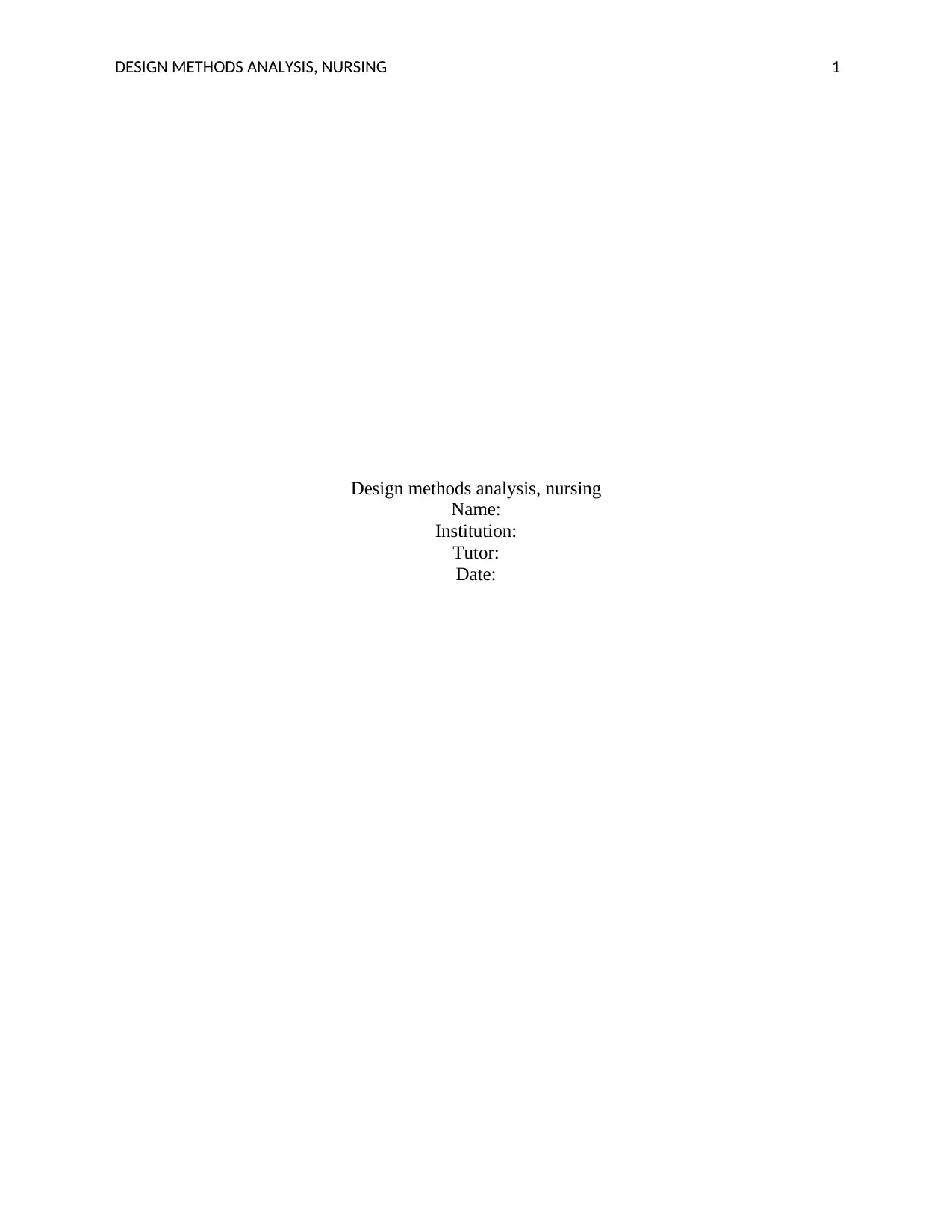
DESIGN METHODS ANALYSIS, NURSING 1
Design methods analysis, nursing
Name:
Institution:
Tutor:
Date:
Design methods analysis, nursing
Name:
Institution:
Tutor:
Date:
Paraphrase This Document
Need a fresh take? Get an instant paraphrase of this document with our AI Paraphraser
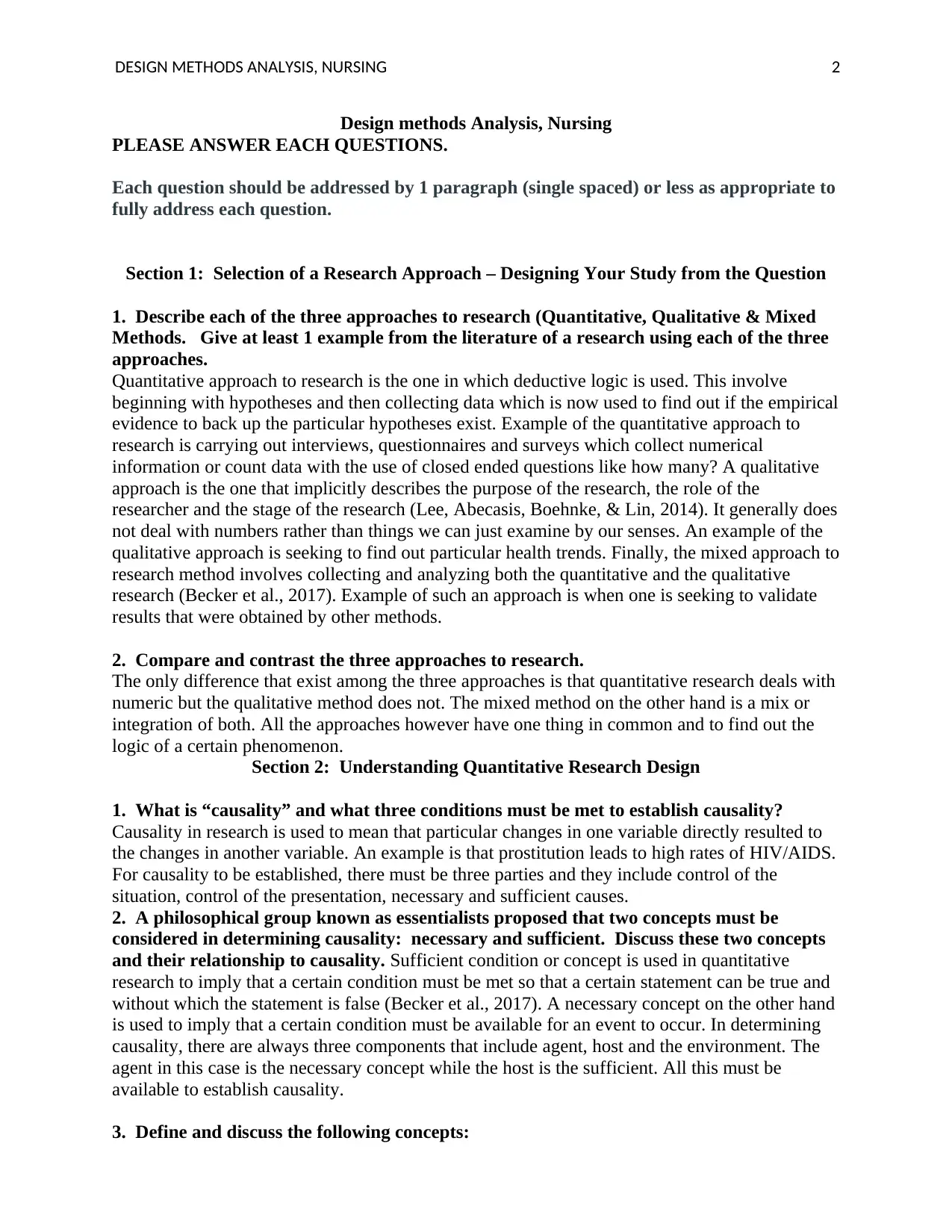
DESIGN METHODS ANALYSIS, NURSING 2
Design methods Analysis, Nursing
PLEASE ANSWER EACH QUESTIONS.
Each question should be addressed by 1 paragraph (single spaced) or less as appropriate to
fully address each question.
Section 1: Selection of a Research Approach – Designing Your Study from the Question
1. Describe each of the three approaches to research (Quantitative, Qualitative & Mixed
Methods. Give at least 1 example from the literature of a research using each of the three
approaches.
Quantitative approach to research is the one in which deductive logic is used. This involve
beginning with hypotheses and then collecting data which is now used to find out if the empirical
evidence to back up the particular hypotheses exist. Example of the quantitative approach to
research is carrying out interviews, questionnaires and surveys which collect numerical
information or count data with the use of closed ended questions like how many? A qualitative
approach is the one that implicitly describes the purpose of the research, the role of the
researcher and the stage of the research (Lee, Abecasis, Boehnke, & Lin, 2014). It generally does
not deal with numbers rather than things we can just examine by our senses. An example of the
qualitative approach is seeking to find out particular health trends. Finally, the mixed approach to
research method involves collecting and analyzing both the quantitative and the qualitative
research (Becker et al., 2017). Example of such an approach is when one is seeking to validate
results that were obtained by other methods.
2. Compare and contrast the three approaches to research.
The only difference that exist among the three approaches is that quantitative research deals with
numeric but the qualitative method does not. The mixed method on the other hand is a mix or
integration of both. All the approaches however have one thing in common and to find out the
logic of a certain phenomenon.
Section 2: Understanding Quantitative Research Design
1. What is “causality” and what three conditions must be met to establish causality?
Causality in research is used to mean that particular changes in one variable directly resulted to
the changes in another variable. An example is that prostitution leads to high rates of HIV/AIDS.
For causality to be established, there must be three parties and they include control of the
situation, control of the presentation, necessary and sufficient causes.
2. A philosophical group known as essentialists proposed that two concepts must be
considered in determining causality: necessary and sufficient. Discuss these two concepts
and their relationship to causality. Sufficient condition or concept is used in quantitative
research to imply that a certain condition must be met so that a certain statement can be true and
without which the statement is false (Becker et al., 2017). A necessary concept on the other hand
is used to imply that a certain condition must be available for an event to occur. In determining
causality, there are always three components that include agent, host and the environment. The
agent in this case is the necessary concept while the host is the sufficient. All this must be
available to establish causality.
3. Define and discuss the following concepts:
Design methods Analysis, Nursing
PLEASE ANSWER EACH QUESTIONS.
Each question should be addressed by 1 paragraph (single spaced) or less as appropriate to
fully address each question.
Section 1: Selection of a Research Approach – Designing Your Study from the Question
1. Describe each of the three approaches to research (Quantitative, Qualitative & Mixed
Methods. Give at least 1 example from the literature of a research using each of the three
approaches.
Quantitative approach to research is the one in which deductive logic is used. This involve
beginning with hypotheses and then collecting data which is now used to find out if the empirical
evidence to back up the particular hypotheses exist. Example of the quantitative approach to
research is carrying out interviews, questionnaires and surveys which collect numerical
information or count data with the use of closed ended questions like how many? A qualitative
approach is the one that implicitly describes the purpose of the research, the role of the
researcher and the stage of the research (Lee, Abecasis, Boehnke, & Lin, 2014). It generally does
not deal with numbers rather than things we can just examine by our senses. An example of the
qualitative approach is seeking to find out particular health trends. Finally, the mixed approach to
research method involves collecting and analyzing both the quantitative and the qualitative
research (Becker et al., 2017). Example of such an approach is when one is seeking to validate
results that were obtained by other methods.
2. Compare and contrast the three approaches to research.
The only difference that exist among the three approaches is that quantitative research deals with
numeric but the qualitative method does not. The mixed method on the other hand is a mix or
integration of both. All the approaches however have one thing in common and to find out the
logic of a certain phenomenon.
Section 2: Understanding Quantitative Research Design
1. What is “causality” and what three conditions must be met to establish causality?
Causality in research is used to mean that particular changes in one variable directly resulted to
the changes in another variable. An example is that prostitution leads to high rates of HIV/AIDS.
For causality to be established, there must be three parties and they include control of the
situation, control of the presentation, necessary and sufficient causes.
2. A philosophical group known as essentialists proposed that two concepts must be
considered in determining causality: necessary and sufficient. Discuss these two concepts
and their relationship to causality. Sufficient condition or concept is used in quantitative
research to imply that a certain condition must be met so that a certain statement can be true and
without which the statement is false (Becker et al., 2017). A necessary concept on the other hand
is used to imply that a certain condition must be available for an event to occur. In determining
causality, there are always three components that include agent, host and the environment. The
agent in this case is the necessary concept while the host is the sufficient. All this must be
available to establish causality.
3. Define and discuss the following concepts:
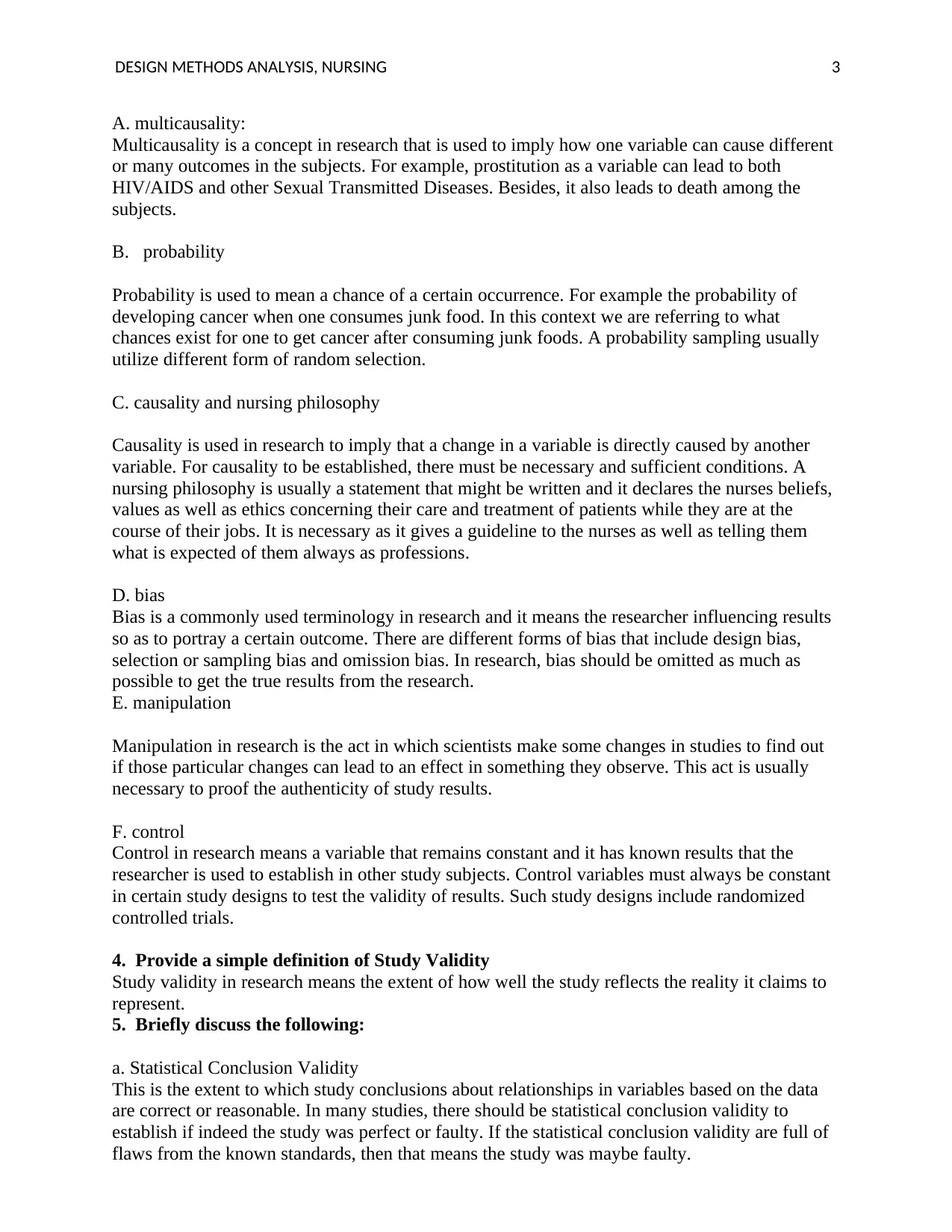
DESIGN METHODS ANALYSIS, NURSING 3
A. multicausality:
Multicausality is a concept in research that is used to imply how one variable can cause different
or many outcomes in the subjects. For example, prostitution as a variable can lead to both
HIV/AIDS and other Sexual Transmitted Diseases. Besides, it also leads to death among the
subjects.
B. probability
Probability is used to mean a chance of a certain occurrence. For example the probability of
developing cancer when one consumes junk food. In this context we are referring to what
chances exist for one to get cancer after consuming junk foods. A probability sampling usually
utilize different form of random selection.
C. causality and nursing philosophy
Causality is used in research to imply that a change in a variable is directly caused by another
variable. For causality to be established, there must be necessary and sufficient conditions. A
nursing philosophy is usually a statement that might be written and it declares the nurses beliefs,
values as well as ethics concerning their care and treatment of patients while they are at the
course of their jobs. It is necessary as it gives a guideline to the nurses as well as telling them
what is expected of them always as professions.
D. bias
Bias is a commonly used terminology in research and it means the researcher influencing results
so as to portray a certain outcome. There are different forms of bias that include design bias,
selection or sampling bias and omission bias. In research, bias should be omitted as much as
possible to get the true results from the research.
E. manipulation
Manipulation in research is the act in which scientists make some changes in studies to find out
if those particular changes can lead to an effect in something they observe. This act is usually
necessary to proof the authenticity of study results.
F. control
Control in research means a variable that remains constant and it has known results that the
researcher is used to establish in other study subjects. Control variables must always be constant
in certain study designs to test the validity of results. Such study designs include randomized
controlled trials.
4. Provide a simple definition of Study Validity
Study validity in research means the extent of how well the study reflects the reality it claims to
represent.
5. Briefly discuss the following:
a. Statistical Conclusion Validity
This is the extent to which study conclusions about relationships in variables based on the data
are correct or reasonable. In many studies, there should be statistical conclusion validity to
establish if indeed the study was perfect or faulty. If the statistical conclusion validity are full of
flaws from the known standards, then that means the study was maybe faulty.
A. multicausality:
Multicausality is a concept in research that is used to imply how one variable can cause different
or many outcomes in the subjects. For example, prostitution as a variable can lead to both
HIV/AIDS and other Sexual Transmitted Diseases. Besides, it also leads to death among the
subjects.
B. probability
Probability is used to mean a chance of a certain occurrence. For example the probability of
developing cancer when one consumes junk food. In this context we are referring to what
chances exist for one to get cancer after consuming junk foods. A probability sampling usually
utilize different form of random selection.
C. causality and nursing philosophy
Causality is used in research to imply that a change in a variable is directly caused by another
variable. For causality to be established, there must be necessary and sufficient conditions. A
nursing philosophy is usually a statement that might be written and it declares the nurses beliefs,
values as well as ethics concerning their care and treatment of patients while they are at the
course of their jobs. It is necessary as it gives a guideline to the nurses as well as telling them
what is expected of them always as professions.
D. bias
Bias is a commonly used terminology in research and it means the researcher influencing results
so as to portray a certain outcome. There are different forms of bias that include design bias,
selection or sampling bias and omission bias. In research, bias should be omitted as much as
possible to get the true results from the research.
E. manipulation
Manipulation in research is the act in which scientists make some changes in studies to find out
if those particular changes can lead to an effect in something they observe. This act is usually
necessary to proof the authenticity of study results.
F. control
Control in research means a variable that remains constant and it has known results that the
researcher is used to establish in other study subjects. Control variables must always be constant
in certain study designs to test the validity of results. Such study designs include randomized
controlled trials.
4. Provide a simple definition of Study Validity
Study validity in research means the extent of how well the study reflects the reality it claims to
represent.
5. Briefly discuss the following:
a. Statistical Conclusion Validity
This is the extent to which study conclusions about relationships in variables based on the data
are correct or reasonable. In many studies, there should be statistical conclusion validity to
establish if indeed the study was perfect or faulty. If the statistical conclusion validity are full of
flaws from the known standards, then that means the study was maybe faulty.
⊘ This is a preview!⊘
Do you want full access?
Subscribe today to unlock all pages.

Trusted by 1+ million students worldwide
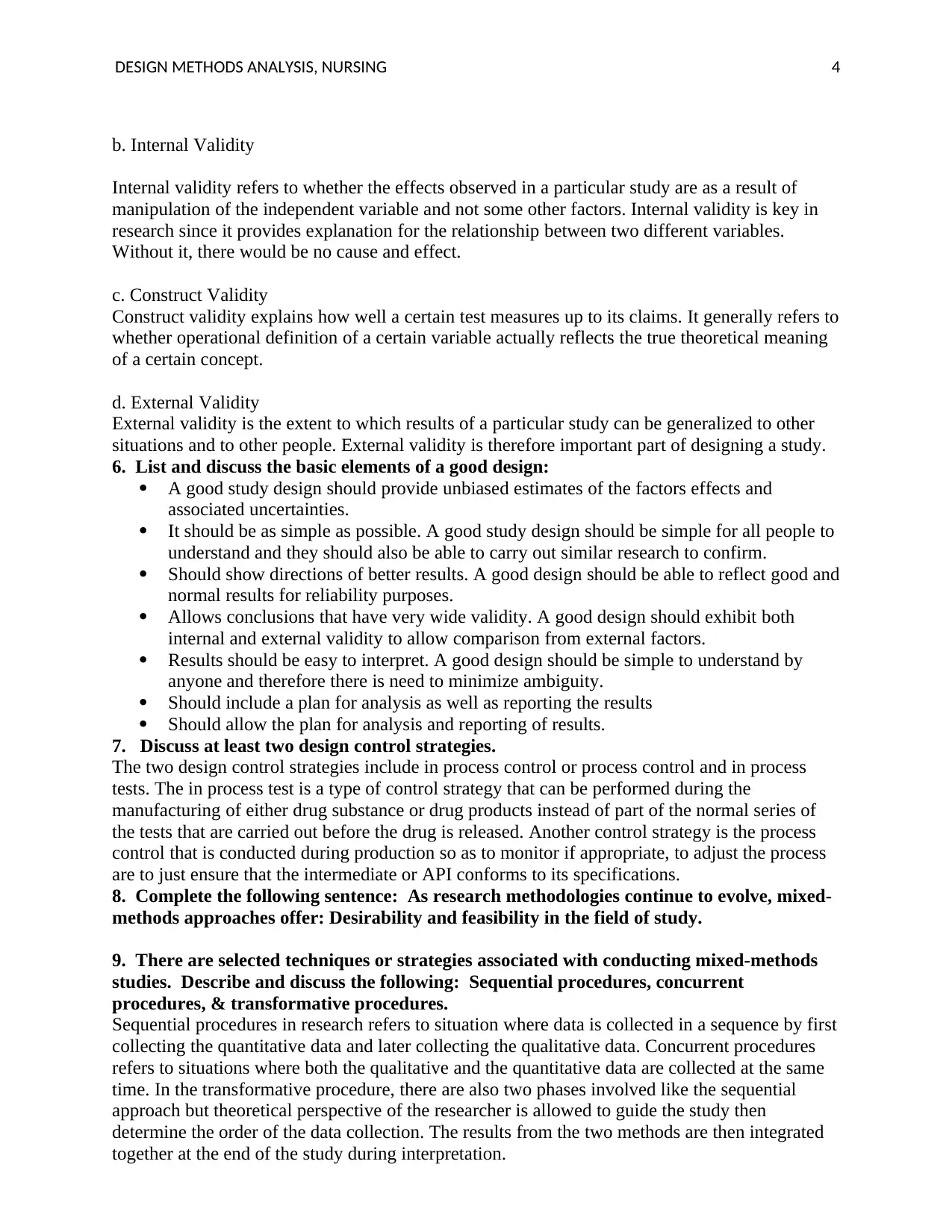
DESIGN METHODS ANALYSIS, NURSING 4
b. Internal Validity
Internal validity refers to whether the effects observed in a particular study are as a result of
manipulation of the independent variable and not some other factors. Internal validity is key in
research since it provides explanation for the relationship between two different variables.
Without it, there would be no cause and effect.
c. Construct Validity
Construct validity explains how well a certain test measures up to its claims. It generally refers to
whether operational definition of a certain variable actually reflects the true theoretical meaning
of a certain concept.
d. External Validity
External validity is the extent to which results of a particular study can be generalized to other
situations and to other people. External validity is therefore important part of designing a study.
6. List and discuss the basic elements of a good design:
A good study design should provide unbiased estimates of the factors effects and
associated uncertainties.
It should be as simple as possible. A good study design should be simple for all people to
understand and they should also be able to carry out similar research to confirm.
Should show directions of better results. A good design should be able to reflect good and
normal results for reliability purposes.
Allows conclusions that have very wide validity. A good design should exhibit both
internal and external validity to allow comparison from external factors.
Results should be easy to interpret. A good design should be simple to understand by
anyone and therefore there is need to minimize ambiguity.
Should include a plan for analysis as well as reporting the results
Should allow the plan for analysis and reporting of results.
7. Discuss at least two design control strategies.
The two design control strategies include in process control or process control and in process
tests. The in process test is a type of control strategy that can be performed during the
manufacturing of either drug substance or drug products instead of part of the normal series of
the tests that are carried out before the drug is released. Another control strategy is the process
control that is conducted during production so as to monitor if appropriate, to adjust the process
are to just ensure that the intermediate or API conforms to its specifications.
8. Complete the following sentence: As research methodologies continue to evolve, mixed-
methods approaches offer: Desirability and feasibility in the field of study.
9. There are selected techniques or strategies associated with conducting mixed-methods
studies. Describe and discuss the following: Sequential procedures, concurrent
procedures, & transformative procedures.
Sequential procedures in research refers to situation where data is collected in a sequence by first
collecting the quantitative data and later collecting the qualitative data. Concurrent procedures
refers to situations where both the qualitative and the quantitative data are collected at the same
time. In the transformative procedure, there are also two phases involved like the sequential
approach but theoretical perspective of the researcher is allowed to guide the study then
determine the order of the data collection. The results from the two methods are then integrated
together at the end of the study during interpretation.
b. Internal Validity
Internal validity refers to whether the effects observed in a particular study are as a result of
manipulation of the independent variable and not some other factors. Internal validity is key in
research since it provides explanation for the relationship between two different variables.
Without it, there would be no cause and effect.
c. Construct Validity
Construct validity explains how well a certain test measures up to its claims. It generally refers to
whether operational definition of a certain variable actually reflects the true theoretical meaning
of a certain concept.
d. External Validity
External validity is the extent to which results of a particular study can be generalized to other
situations and to other people. External validity is therefore important part of designing a study.
6. List and discuss the basic elements of a good design:
A good study design should provide unbiased estimates of the factors effects and
associated uncertainties.
It should be as simple as possible. A good study design should be simple for all people to
understand and they should also be able to carry out similar research to confirm.
Should show directions of better results. A good design should be able to reflect good and
normal results for reliability purposes.
Allows conclusions that have very wide validity. A good design should exhibit both
internal and external validity to allow comparison from external factors.
Results should be easy to interpret. A good design should be simple to understand by
anyone and therefore there is need to minimize ambiguity.
Should include a plan for analysis as well as reporting the results
Should allow the plan for analysis and reporting of results.
7. Discuss at least two design control strategies.
The two design control strategies include in process control or process control and in process
tests. The in process test is a type of control strategy that can be performed during the
manufacturing of either drug substance or drug products instead of part of the normal series of
the tests that are carried out before the drug is released. Another control strategy is the process
control that is conducted during production so as to monitor if appropriate, to adjust the process
are to just ensure that the intermediate or API conforms to its specifications.
8. Complete the following sentence: As research methodologies continue to evolve, mixed-
methods approaches offer: Desirability and feasibility in the field of study.
9. There are selected techniques or strategies associated with conducting mixed-methods
studies. Describe and discuss the following: Sequential procedures, concurrent
procedures, & transformative procedures.
Sequential procedures in research refers to situation where data is collected in a sequence by first
collecting the quantitative data and later collecting the qualitative data. Concurrent procedures
refers to situations where both the qualitative and the quantitative data are collected at the same
time. In the transformative procedure, there are also two phases involved like the sequential
approach but theoretical perspective of the researcher is allowed to guide the study then
determine the order of the data collection. The results from the two methods are then integrated
together at the end of the study during interpretation.
Paraphrase This Document
Need a fresh take? Get an instant paraphrase of this document with our AI Paraphraser
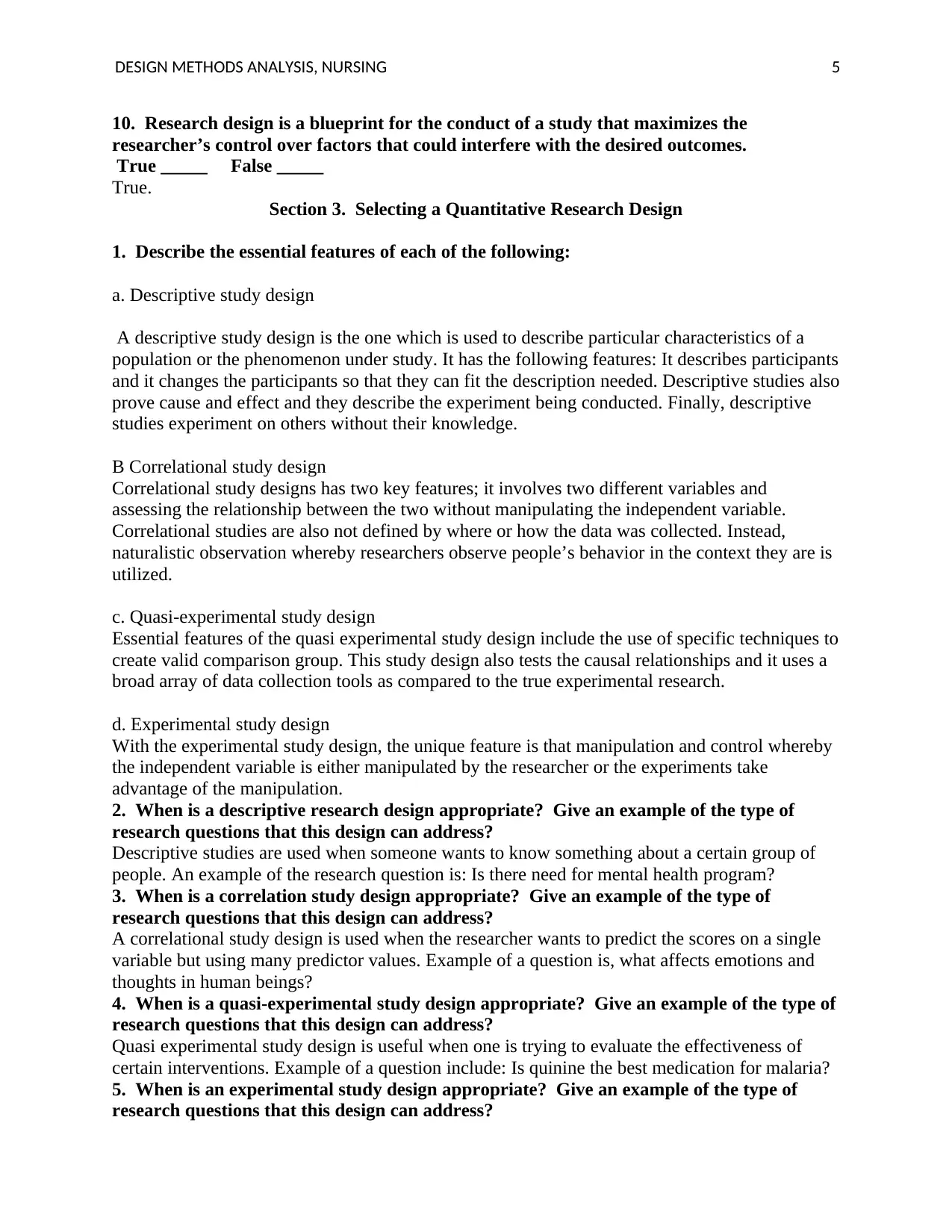
DESIGN METHODS ANALYSIS, NURSING 5
10. Research design is a blueprint for the conduct of a study that maximizes the
researcher’s control over factors that could interfere with the desired outcomes.
True _____ False _____
True.
Section 3. Selecting a Quantitative Research Design
1. Describe the essential features of each of the following:
a. Descriptive study design
A descriptive study design is the one which is used to describe particular characteristics of a
population or the phenomenon under study. It has the following features: It describes participants
and it changes the participants so that they can fit the description needed. Descriptive studies also
prove cause and effect and they describe the experiment being conducted. Finally, descriptive
studies experiment on others without their knowledge.
B Correlational study design
Correlational study designs has two key features; it involves two different variables and
assessing the relationship between the two without manipulating the independent variable.
Correlational studies are also not defined by where or how the data was collected. Instead,
naturalistic observation whereby researchers observe people’s behavior in the context they are is
utilized.
c. Quasi-experimental study design
Essential features of the quasi experimental study design include the use of specific techniques to
create valid comparison group. This study design also tests the causal relationships and it uses a
broad array of data collection tools as compared to the true experimental research.
d. Experimental study design
With the experimental study design, the unique feature is that manipulation and control whereby
the independent variable is either manipulated by the researcher or the experiments take
advantage of the manipulation.
2. When is a descriptive research design appropriate? Give an example of the type of
research questions that this design can address?
Descriptive studies are used when someone wants to know something about a certain group of
people. An example of the research question is: Is there need for mental health program?
3. When is a correlation study design appropriate? Give an example of the type of
research questions that this design can address?
A correlational study design is used when the researcher wants to predict the scores on a single
variable but using many predictor values. Example of a question is, what affects emotions and
thoughts in human beings?
4. When is a quasi-experimental study design appropriate? Give an example of the type of
research questions that this design can address?
Quasi experimental study design is useful when one is trying to evaluate the effectiveness of
certain interventions. Example of a question include: Is quinine the best medication for malaria?
5. When is an experimental study design appropriate? Give an example of the type of
research questions that this design can address?
10. Research design is a blueprint for the conduct of a study that maximizes the
researcher’s control over factors that could interfere with the desired outcomes.
True _____ False _____
True.
Section 3. Selecting a Quantitative Research Design
1. Describe the essential features of each of the following:
a. Descriptive study design
A descriptive study design is the one which is used to describe particular characteristics of a
population or the phenomenon under study. It has the following features: It describes participants
and it changes the participants so that they can fit the description needed. Descriptive studies also
prove cause and effect and they describe the experiment being conducted. Finally, descriptive
studies experiment on others without their knowledge.
B Correlational study design
Correlational study designs has two key features; it involves two different variables and
assessing the relationship between the two without manipulating the independent variable.
Correlational studies are also not defined by where or how the data was collected. Instead,
naturalistic observation whereby researchers observe people’s behavior in the context they are is
utilized.
c. Quasi-experimental study design
Essential features of the quasi experimental study design include the use of specific techniques to
create valid comparison group. This study design also tests the causal relationships and it uses a
broad array of data collection tools as compared to the true experimental research.
d. Experimental study design
With the experimental study design, the unique feature is that manipulation and control whereby
the independent variable is either manipulated by the researcher or the experiments take
advantage of the manipulation.
2. When is a descriptive research design appropriate? Give an example of the type of
research questions that this design can address?
Descriptive studies are used when someone wants to know something about a certain group of
people. An example of the research question is: Is there need for mental health program?
3. When is a correlation study design appropriate? Give an example of the type of
research questions that this design can address?
A correlational study design is used when the researcher wants to predict the scores on a single
variable but using many predictor values. Example of a question is, what affects emotions and
thoughts in human beings?
4. When is a quasi-experimental study design appropriate? Give an example of the type of
research questions that this design can address?
Quasi experimental study design is useful when one is trying to evaluate the effectiveness of
certain interventions. Example of a question include: Is quinine the best medication for malaria?
5. When is an experimental study design appropriate? Give an example of the type of
research questions that this design can address?
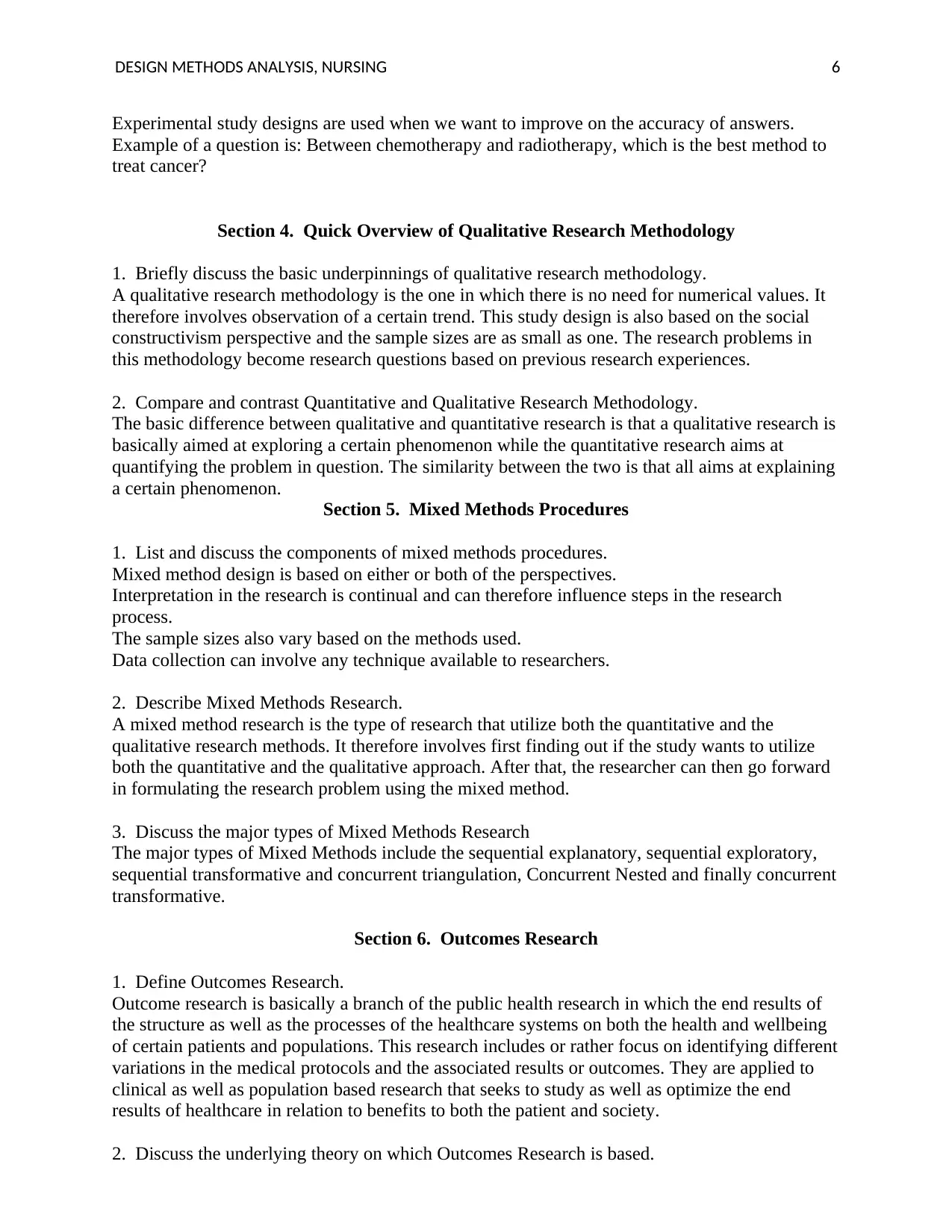
DESIGN METHODS ANALYSIS, NURSING 6
Experimental study designs are used when we want to improve on the accuracy of answers.
Example of a question is: Between chemotherapy and radiotherapy, which is the best method to
treat cancer?
Section 4. Quick Overview of Qualitative Research Methodology
1. Briefly discuss the basic underpinnings of qualitative research methodology.
A qualitative research methodology is the one in which there is no need for numerical values. It
therefore involves observation of a certain trend. This study design is also based on the social
constructivism perspective and the sample sizes are as small as one. The research problems in
this methodology become research questions based on previous research experiences.
2. Compare and contrast Quantitative and Qualitative Research Methodology.
The basic difference between qualitative and quantitative research is that a qualitative research is
basically aimed at exploring a certain phenomenon while the quantitative research aims at
quantifying the problem in question. The similarity between the two is that all aims at explaining
a certain phenomenon.
Section 5. Mixed Methods Procedures
1. List and discuss the components of mixed methods procedures.
Mixed method design is based on either or both of the perspectives.
Interpretation in the research is continual and can therefore influence steps in the research
process.
The sample sizes also vary based on the methods used.
Data collection can involve any technique available to researchers.
2. Describe Mixed Methods Research.
A mixed method research is the type of research that utilize both the quantitative and the
qualitative research methods. It therefore involves first finding out if the study wants to utilize
both the quantitative and the qualitative approach. After that, the researcher can then go forward
in formulating the research problem using the mixed method.
3. Discuss the major types of Mixed Methods Research
The major types of Mixed Methods include the sequential explanatory, sequential exploratory,
sequential transformative and concurrent triangulation, Concurrent Nested and finally concurrent
transformative.
Section 6. Outcomes Research
1. Define Outcomes Research.
Outcome research is basically a branch of the public health research in which the end results of
the structure as well as the processes of the healthcare systems on both the health and wellbeing
of certain patients and populations. This research includes or rather focus on identifying different
variations in the medical protocols and the associated results or outcomes. They are applied to
clinical as well as population based research that seeks to study as well as optimize the end
results of healthcare in relation to benefits to both the patient and society.
2. Discuss the underlying theory on which Outcomes Research is based.
Experimental study designs are used when we want to improve on the accuracy of answers.
Example of a question is: Between chemotherapy and radiotherapy, which is the best method to
treat cancer?
Section 4. Quick Overview of Qualitative Research Methodology
1. Briefly discuss the basic underpinnings of qualitative research methodology.
A qualitative research methodology is the one in which there is no need for numerical values. It
therefore involves observation of a certain trend. This study design is also based on the social
constructivism perspective and the sample sizes are as small as one. The research problems in
this methodology become research questions based on previous research experiences.
2. Compare and contrast Quantitative and Qualitative Research Methodology.
The basic difference between qualitative and quantitative research is that a qualitative research is
basically aimed at exploring a certain phenomenon while the quantitative research aims at
quantifying the problem in question. The similarity between the two is that all aims at explaining
a certain phenomenon.
Section 5. Mixed Methods Procedures
1. List and discuss the components of mixed methods procedures.
Mixed method design is based on either or both of the perspectives.
Interpretation in the research is continual and can therefore influence steps in the research
process.
The sample sizes also vary based on the methods used.
Data collection can involve any technique available to researchers.
2. Describe Mixed Methods Research.
A mixed method research is the type of research that utilize both the quantitative and the
qualitative research methods. It therefore involves first finding out if the study wants to utilize
both the quantitative and the qualitative approach. After that, the researcher can then go forward
in formulating the research problem using the mixed method.
3. Discuss the major types of Mixed Methods Research
The major types of Mixed Methods include the sequential explanatory, sequential exploratory,
sequential transformative and concurrent triangulation, Concurrent Nested and finally concurrent
transformative.
Section 6. Outcomes Research
1. Define Outcomes Research.
Outcome research is basically a branch of the public health research in which the end results of
the structure as well as the processes of the healthcare systems on both the health and wellbeing
of certain patients and populations. This research includes or rather focus on identifying different
variations in the medical protocols and the associated results or outcomes. They are applied to
clinical as well as population based research that seeks to study as well as optimize the end
results of healthcare in relation to benefits to both the patient and society.
2. Discuss the underlying theory on which Outcomes Research is based.
⊘ This is a preview!⊘
Do you want full access?
Subscribe today to unlock all pages.

Trusted by 1+ million students worldwide
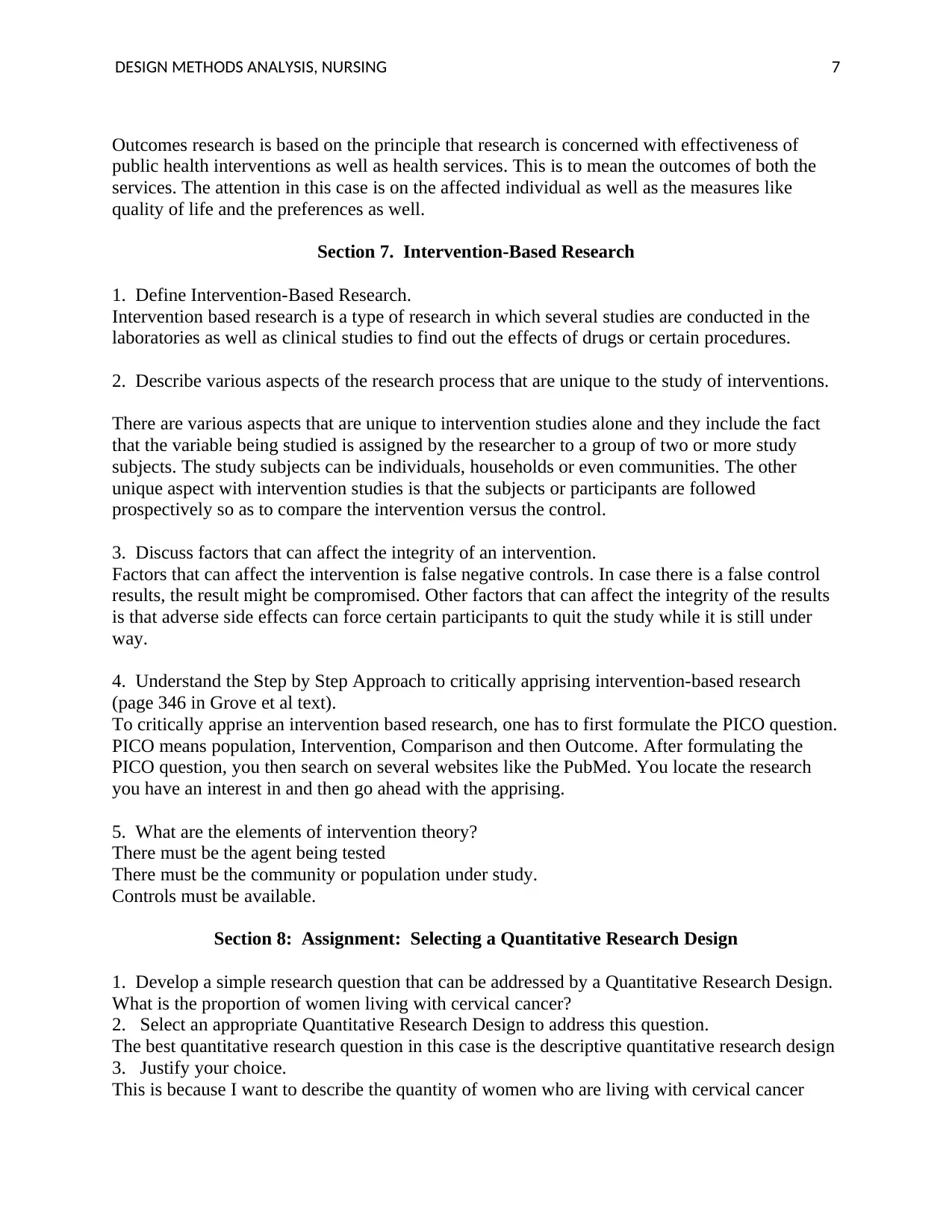
DESIGN METHODS ANALYSIS, NURSING 7
Outcomes research is based on the principle that research is concerned with effectiveness of
public health interventions as well as health services. This is to mean the outcomes of both the
services. The attention in this case is on the affected individual as well as the measures like
quality of life and the preferences as well.
Section 7. Intervention-Based Research
1. Define Intervention-Based Research.
Intervention based research is a type of research in which several studies are conducted in the
laboratories as well as clinical studies to find out the effects of drugs or certain procedures.
2. Describe various aspects of the research process that are unique to the study of interventions.
There are various aspects that are unique to intervention studies alone and they include the fact
that the variable being studied is assigned by the researcher to a group of two or more study
subjects. The study subjects can be individuals, households or even communities. The other
unique aspect with intervention studies is that the subjects or participants are followed
prospectively so as to compare the intervention versus the control.
3. Discuss factors that can affect the integrity of an intervention.
Factors that can affect the intervention is false negative controls. In case there is a false control
results, the result might be compromised. Other factors that can affect the integrity of the results
is that adverse side effects can force certain participants to quit the study while it is still under
way.
4. Understand the Step by Step Approach to critically apprising intervention-based research
(page 346 in Grove et al text).
To critically apprise an intervention based research, one has to first formulate the PICO question.
PICO means population, Intervention, Comparison and then Outcome. After formulating the
PICO question, you then search on several websites like the PubMed. You locate the research
you have an interest in and then go ahead with the apprising.
5. What are the elements of intervention theory?
There must be the agent being tested
There must be the community or population under study.
Controls must be available.
Section 8: Assignment: Selecting a Quantitative Research Design
1. Develop a simple research question that can be addressed by a Quantitative Research Design.
What is the proportion of women living with cervical cancer?
2. Select an appropriate Quantitative Research Design to address this question.
The best quantitative research question in this case is the descriptive quantitative research design
3. Justify your choice.
This is because I want to describe the quantity of women who are living with cervical cancer
Outcomes research is based on the principle that research is concerned with effectiveness of
public health interventions as well as health services. This is to mean the outcomes of both the
services. The attention in this case is on the affected individual as well as the measures like
quality of life and the preferences as well.
Section 7. Intervention-Based Research
1. Define Intervention-Based Research.
Intervention based research is a type of research in which several studies are conducted in the
laboratories as well as clinical studies to find out the effects of drugs or certain procedures.
2. Describe various aspects of the research process that are unique to the study of interventions.
There are various aspects that are unique to intervention studies alone and they include the fact
that the variable being studied is assigned by the researcher to a group of two or more study
subjects. The study subjects can be individuals, households or even communities. The other
unique aspect with intervention studies is that the subjects or participants are followed
prospectively so as to compare the intervention versus the control.
3. Discuss factors that can affect the integrity of an intervention.
Factors that can affect the intervention is false negative controls. In case there is a false control
results, the result might be compromised. Other factors that can affect the integrity of the results
is that adverse side effects can force certain participants to quit the study while it is still under
way.
4. Understand the Step by Step Approach to critically apprising intervention-based research
(page 346 in Grove et al text).
To critically apprise an intervention based research, one has to first formulate the PICO question.
PICO means population, Intervention, Comparison and then Outcome. After formulating the
PICO question, you then search on several websites like the PubMed. You locate the research
you have an interest in and then go ahead with the apprising.
5. What are the elements of intervention theory?
There must be the agent being tested
There must be the community or population under study.
Controls must be available.
Section 8: Assignment: Selecting a Quantitative Research Design
1. Develop a simple research question that can be addressed by a Quantitative Research Design.
What is the proportion of women living with cervical cancer?
2. Select an appropriate Quantitative Research Design to address this question.
The best quantitative research question in this case is the descriptive quantitative research design
3. Justify your choice.
This is because I want to describe the quantity of women who are living with cervical cancer
Paraphrase This Document
Need a fresh take? Get an instant paraphrase of this document with our AI Paraphraser
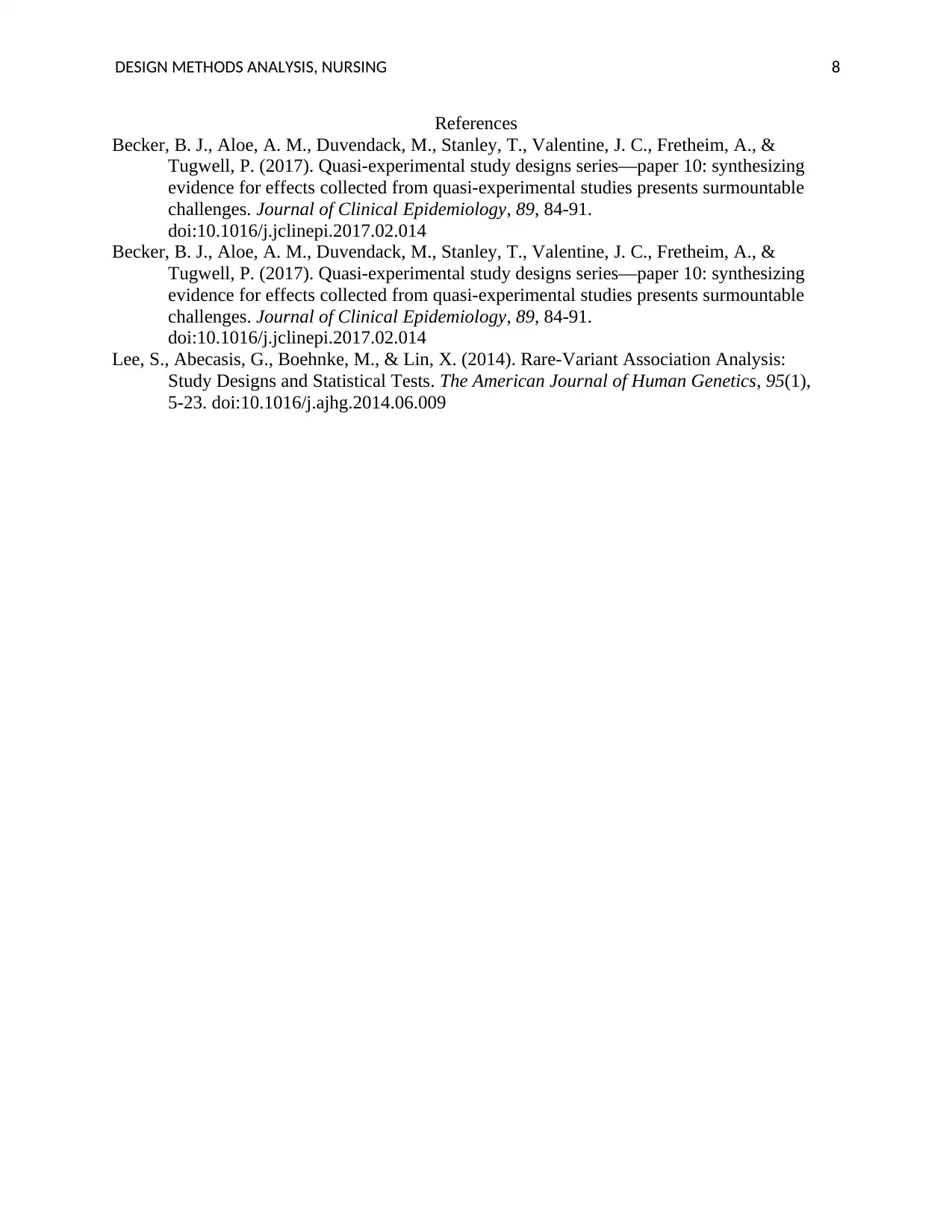
DESIGN METHODS ANALYSIS, NURSING 8
References
Becker, B. J., Aloe, A. M., Duvendack, M., Stanley, T., Valentine, J. C., Fretheim, A., &
Tugwell, P. (2017). Quasi-experimental study designs series—paper 10: synthesizing
evidence for effects collected from quasi-experimental studies presents surmountable
challenges. Journal of Clinical Epidemiology, 89, 84-91.
doi:10.1016/j.jclinepi.2017.02.014
Becker, B. J., Aloe, A. M., Duvendack, M., Stanley, T., Valentine, J. C., Fretheim, A., &
Tugwell, P. (2017). Quasi-experimental study designs series—paper 10: synthesizing
evidence for effects collected from quasi-experimental studies presents surmountable
challenges. Journal of Clinical Epidemiology, 89, 84-91.
doi:10.1016/j.jclinepi.2017.02.014
Lee, S., Abecasis, G., Boehnke, M., & Lin, X. (2014). Rare-Variant Association Analysis:
Study Designs and Statistical Tests. The American Journal of Human Genetics, 95(1),
5-23. doi:10.1016/j.ajhg.2014.06.009
References
Becker, B. J., Aloe, A. M., Duvendack, M., Stanley, T., Valentine, J. C., Fretheim, A., &
Tugwell, P. (2017). Quasi-experimental study designs series—paper 10: synthesizing
evidence for effects collected from quasi-experimental studies presents surmountable
challenges. Journal of Clinical Epidemiology, 89, 84-91.
doi:10.1016/j.jclinepi.2017.02.014
Becker, B. J., Aloe, A. M., Duvendack, M., Stanley, T., Valentine, J. C., Fretheim, A., &
Tugwell, P. (2017). Quasi-experimental study designs series—paper 10: synthesizing
evidence for effects collected from quasi-experimental studies presents surmountable
challenges. Journal of Clinical Epidemiology, 89, 84-91.
doi:10.1016/j.jclinepi.2017.02.014
Lee, S., Abecasis, G., Boehnke, M., & Lin, X. (2014). Rare-Variant Association Analysis:
Study Designs and Statistical Tests. The American Journal of Human Genetics, 95(1),
5-23. doi:10.1016/j.ajhg.2014.06.009
1 out of 8
Related Documents
Your All-in-One AI-Powered Toolkit for Academic Success.
+13062052269
info@desklib.com
Available 24*7 on WhatsApp / Email
![[object Object]](/_next/static/media/star-bottom.7253800d.svg)
Unlock your academic potential
Copyright © 2020–2025 A2Z Services. All Rights Reserved. Developed and managed by ZUCOL.




